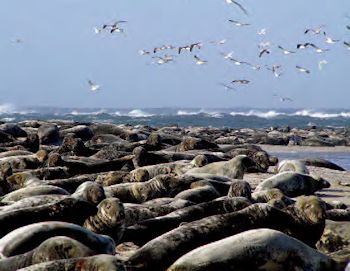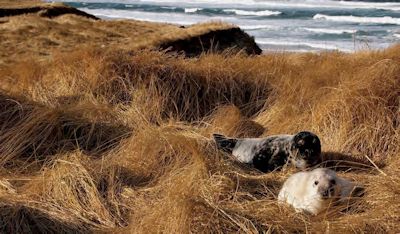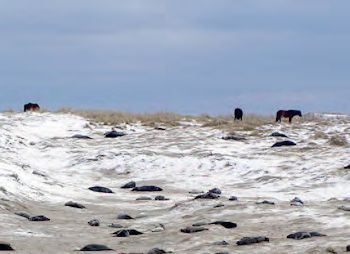SEJournal Online is the digital news magazine of the Society of Environmental Journalists. Learn more about SEJournal Online, including submission, subscription and advertising information.
Between the Lines
 |
|
Adult grey seals hauled out along the south beach of Sable Island, a narrow 26-mile-long sand spit notorious for shipwrecks in the Atlantic Ocean 180 miles south of Nova Scotia, where approximately 50,000 of them live. |
For the latest Between the Lines — a question-and-answer feature in which published authors provide advice to SEJ members — SEJournal book editor Tom Henry interviewed Nova Scotia-based environmental writer Linda Pannozzo about "The Devil & The Deep Blue Sea: An Investigation into the Scapegoating of Canada's Grey Seal." The book, which explores in part how the species has been blamed for the decline in cod fisheries, received an honorable mention in the Rachel Carson Environment Book Award category of SEJ's most recent annual awards contest.
SEJournal: Your book focuses on how the powerful North Atlantic fishing industry worked with politicians and government scientists to malign a single species, that is Canada's grey seal, for alot of the biological changes occurring in the ocean. How did you get on to this story and what inspired you to stick with it?
Linda Pannozzo: In 2009, a newly elected government in the province of Nova Scotia had not only opened up Hay Island — a protected wilderness area — to commercial sealing, but it proposed to change the Wilderness Areas Protection Act to accommodate it. The argument coming from the government and industry was that the grey seals were harming the biodiversity of the wilderness area by eating too many fish, namely cod, and stunting the recovery of the species.
I attended the public hearings held by the Law Amendments Committee and heard submissions by world-renowned scientists from Dalhousie University who argued there was no science to support the view that the seals were holding back the recovery of cod. One scientist, Boris Worm, even said the seals could be helping the cod. Well, this just got me hooked — if there was no science, then what was behind the push to kill the seals?
Once I began researching the subject I was stunned and absolutely fascinated by the complexity of the issues and this, combined with the possibility of a massive cull of the herds, kept me inspired and committed to carry on despite how daunting the task seemed.
SEJournal: Certainly, you must have encountered adversity along the way — people in authority claiming you were going down the wrong path and trying to steer you in other directions or off the story completely. Were you ever threatened? What extra challenges did you encounter going against the grain and challenging authority and challenging big money?
Pannozzo: I was never personally threatened, though I did feel a certain amount of fear for a couple of reasons. For one, I live in a fishing community and historically on the East coast of Canada there have been violent confrontations between sealers/fishers and animal welfare activists. I wasn't sure how the book would be received by the fishing community. And, quite frankly, I was worried I might be pigeonholed.
But from the very start my aim was not to feed into what had become a highly polarized issue, because in reality these simplifications and dichotomies don't even begin to address the complexities at hand. So far, I haven't received any negative feedback and I think for the most part the book is considered to be very evenhanded and fair.
 |
|
Two grey seal pups, one a whitecoat, the other molting into an adult dark coat, on Sable Island. |
In addition, I'm not a fisheries scientist. I'm a journalist and journalists are seldom experts in the field they are writing about. So when I began researching the book and communicating with government scientists — and later challenging some of them — I was greeted with a certain amount of resistance. I was also amazed by the bravery of some of them, one in particular who took great risk to speak to me very frankly despite how it could impact his career.
In the epilogue of the book I also discuss how the current Canadian government policy around the granting of interviews to the media made it very difficult for me to interview some key government scientists and how an Access to Information Request that I filed revealed that the Department of Fisheries and Oceans' communication branch was not only tightly controlling the information but in some cases was suppressing and censoring it. On several occasions government scientists expressed how wary they were about making any statements that could get them into trouble. What is particularly worrying about this is that anything that inhibits the communication of science also inhibits the science.
SEJournal: What lessons did you learn from researching and writing this book? How did it put your street savvy and reporting expertise to work? How did you know whom to trust?
Pannozzo: One thing I learned is don't believe anything someone tells you until you have verified that it's true. This can sometimes take a lot of time and effort, but don't get lazy and give up because it could mean you end up reporting misinformation. Many people have very strong opinions about this issue and not all opinions are based on fact.
When I started out writing the book I thought I'd find out the definitive answer as to why the cod hadn't recovered. I thought that if I read enough studies and interviewed enough people I'd be able to narrow it down to one thing — find the smoking gun. But what I found is that it's much too complex and we just don't know the answer. There are too many unknowns and then there are the unknown unknowns. This doesn't mean we shouldn't act to protect the marine ecosystem, but it means we need to proceed with extreme caution. So writing this book has made me much more humble and it also made me see that as a reporter it might be more important to report the uncertainties.
SEJournal: The book is meticulously researched, with what appears to be painstaking reporting packed into a relatively short narrative. But there also is a lot of color and descriptive writing. What advice do you have for writers trying to find the sweet spot between prose, passion and hard-nosed reporting so that they neither come away writing flowery rhetoric nor drab science?
Pannozzo: I'm certainly no expert in creative non-fiction, but from the start my intention was to write a book for a lay audience, so I didn't want it to come across as academic or dry. I really wanted it to come to life — for it to be real for the reader in such a way that it would make them care about the ocean and its creatures. I didn't do this in any formulaic way. But I figured that if there was something that I found fascinating or interesting, or something that made me care, then there was a pretty good chance a reader might feel the same way. So my advice to writers would be to find the parts of the story that fascinate you and use that to draw the reader in.
SEJournal: What has this book taught you about accountability and about peeling away the layers of the official news we get from those in power, i.e., looking for the story behind the story?
Pannozzo: I have always felt the role of journalism in our society is to look beyond what we get from official sources, to be able to recognize propaganda on all sides of an issue and in the end report on behalf of the public interest. Working on this book has only strengthened that sentiment.
SEJournal: Has the cod fishery rebounded yet much? What about the grey seals? Do you see either on the path toward recovery? Or are both still in limbo over fisheries management issues and continuing uncertainty over climate change?
Pannozzo: Cod and grey seals have been on different trajectories over the last several decades. Adult cod still seem to be disappearing and the grey seal population has recovered from what were dangerously low levels. In the book, I reported that during the exponential growth phase of the grey seal population, roughly 70 percent of juveniles (that is, prior to age of sexual maturity, 5, 6, 7 years old) were surviving. But now they are finding that only 33 percent of juveniles are surviving. They are attributing this to lack of food and that the juveniles are being outcompeted by the older animals, and this is probably why the exponential growth has stopped — and why the population is likely near its carrying capacity.
There has been no real improvement in fisheries management. There is still no recovery strategy for cod, there are no targets or timelines even though four stocks of cod have been identified as "endangered." This is because cod haven't been "listed" under the Species at Risk Act. Listing would automatically result in a recovery strategy. But the Department of Fisheries and Oceans won't agree to list cod because of how this might affect the execution of other economically viable fisheries.
In terms of where things currently stand regarding a cull, it's still in a kind of limbo. The most recent high-level recommendation for a massive grey cull was "killed" when Stephen Harper's government discontinued the session of parliament in late August of 2013. So, to date no decisions have been made about a cull but it's my guess that this issue will be rearing its head again.
 |
|
The 50,000 grey seals on Sable Island share the island with over 500 feral wild horses that were introduced there in the nineteenth century. |
SEJournal: What unique challenges does Nova Scotia face, both on land and at sea, and what are some take-home points for environmental journalists from the United States and other parts of Canada?
Pannozzo: I live in a beautiful seaside community in Nova Scotia — a very small, mostly rural Canadian province that historically was "resource-based," where employment and wealth was created largely by cutting big trees and catching big fish — essentially extracting goods from nature. When the cod and other groundfish collapsed in the early 1990s, the fabric of these communities unraveled. Many fishermen who remained in the fishery adapted to the crisis by entering the growing lobster fishery and are now dependent on a species at the bottom of the marine food web. Given how higher temperatures and acidification associated with climate change are predicted to affect lobsters and other larvae-producing sea creatures, if anything were to go wrong in the lobster fishery it means there's no room to maneuver.
Also, I think the interests of the fishing industry in Nova Scotia and elsewhere on the East coast are diametrically opposed to the interests of the inshore fishermen and the communities in which they live. The mantra of growth is touted by the fishing industry and if it can't grow anymore by catching more fish, then the only way for it to increase productivity is by reducing employment — or replacing fishermen with technology — and this is how small communities wither and die.
Nova Scotia's past has largely been extractivist, and there are those here who would like that to continue by promoting fracking and offshore oil and gas exploration. But this has to change because we now know we can't have unlimited growth on a finite planet; we know that many corporations are profitable because they externalize costs. We also know that the public interest has taken a backseat to corporate/vested interests and this seems to be less and less palatable among the general public.
SEJournal: The late Farley Mowat described "The Devil & the Deep Blue Sea" as "one of the most significant books to appear in modern times." What did it mean to have him quoted on the book's cover? How did you know him? How did he inspire you? What did you learn from him and what do you miss about him?
Pannozzo: Sometime in August of 2013 I received a phone call from Farley Mowat, arguably Canada's most successful author — he's written more than 40 books, selling 18 million copies in 60 countries — and he's one of Canada's most renowned conservationists. I've never had the pleasure of meeting Farley, but another wonderful author I know — Silver Donald Cameron — insisted he could bring Farley my manuscript. They were almost neighbors, both living the warmer part of the year in rural Cape Breton, an island attached to Nova Scotia by a causeway. I was honored by the gesture but had little expectation that it would amount to anything.
When Farley called, I nearly fell off my seat! He told me he couldn't put the book down, and that it was a book he wished he had written. "An absolutely stupendous job," he told me. "I really can’t tell you how much I'm impressed by your work." His recognition meant the world to me.
Because Farley used a typewriter and sent mail the old-fashioned way, he said he would call me the next day with his “endorsement” and if I wasn't home he was going to leave it in a voice message. I still have that voice message, more than a year later. He also sent me a copy of it in the mail — a marked-up page with two typed draft versions of the review, both of them crossed out with large X's and then the cleaned up version at the bottom of the page. All the editing was done by hand.
Farley was a fearless and outspoken champion for the natural world. His books, namely "Never Cry Wolf," "Virunga," "A Whale for the Killing" and "Sea of Slaughter," were astonishing and very influential in shaping my worldview growing up. There is no one else quite like him.
Tom Henry is SEJournal’s book editor and a former SEJ board member. He has been associated with SEJ since 1994.
* From the quarterly newsletter SEJournal, Fall 2014. Each new issue of SEJournal is available to members and subscribers only; find subscription information here or learn how to join SEJ. Past issues are archived for the public here.












 Advertisement
Advertisement 



